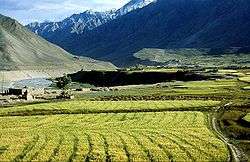Doda River
| Doda River | |
| Stod River | |
| River | |
 Stod River | |
| Country | India |
|---|---|
| State | Jammu and Kashmir |
| Region | Ladakh |
| District | Kargil |
| Tributaries | |
| - right | Tsarap River |
| Source | 33°47′40″N 76°20′22″E / 33.794578°N 76.339341°ECoordinates: 33°47′40″N 76°20′22″E / 33.794578°N 76.339341°E |
| - location | Drang-Drung Glacier at Pensi La |
| - elevation | 4,560 m (14,961 ft) |
| Mouth | 33°30′57″N 76°56′02″E / 33.515855°N 76.933805°E |
| - location | Tsarap River together forms Zanskar River at Padum Zanskar |
| - elevation | 3,485 m (11,434 ft) |
| Length | 79 km (49 mi) |
| Discharge | |
| - average | 206 m3/s (7,275 cu ft/s) |
The Doda River or the Stod River[1] is a river 79 kilometres (49 mi) long, which forms the Stod Valley in the Zanskar valley[2][3] of the Ladakh region in the Indian state of Jammu and Kashmir.[4]
Geography
The Doda River rises from the Drang-Drung Glacier near Pensi La, a mountain pass off the Zanskar-Kargil road.[4][5] The Drang-Drung Glacier is a river of ice and snow by itself and is the largest glacier other than the Siachen Glacier in Ladakh outside the Karakoram Range.[6] It gives rise to a mountain peak named "Doda Peak", 21,490 ft (6,550 metres) high,[7] and it is the namesake for the Doda district, which lies in the rear side of the glacier; the Doda River is also known as Stod River.[1] After rising from its source, the Doda River flows southeast down along the Kargil - Zanskar road in the main Zanskar valley, through the towns of Akshu, Abran, Kushol and Phey. The river then passes a confluence with its tributary, the Tsarap River, at Padum, the capital of Zanskar. Together, these two rivers form the Zanskar River, a tributary of the Indus River.[2]

The Doda River contributes to the minimal agricultural production of the Zanskar valley by providing irrigation to the fields of barley, wheat, buckwheat and peas.[8] Accessible in the summer, the Pensi La mountain pass at the source of the river receives heavy snowfall along with the other pass Zojila, which cuts off the Stod Valley from the rest of the country during winter, and the river freezes during this season. The river source at Pensi La lies 350 kilometres (220 mi) east from the Srinagar, the capital of Jammu and Kashmir.[6] The Doda River is famous for adventure sports. Rafting events are organised throughout the length of the Doda and the Zanskar.[9][10]
References
- 1 2 Hashmat Singh, Pallav Das, Jai Kumar Sharma (2002). Trekking in the Himalayas. Roli Books, 2002. p. -140. ISBN 9788174361066. Retrieved 17 August 2012.
- 1 2 "Stod a tributory of Zanskar river". tourisminjammukashmir. Retrieved 2012-08-17.
- ↑ Robert W. Bradnock, Roma Bradnock (2004). Footprint India Footprint India Handbook. Footprint, 2004. p. -532. ISBN 9781904777007. Retrieved 17 August 2012.
- 1 2 Janet Rizvi (1996). Ladakh: crossroads of high Asia. Oxford University Press, 1996. p. 30–. ISBN 9780195640168. Retrieved 17 August 2012.
- ↑ Kim Gutschow (2004). Being a Buddhist Nun: The Struggle for Enlightenment in the Himalayas. Harvard University Press, 2004. p. -40. ISBN 9780674012875. Retrieved 17 August 2012.
- 1 2 Jasbir Singh (2004). The economy of Jammu & Kashmir. Radha Krishan Anand & Co., 2004. p. 223-. ISBN 9788188256099. Retrieved 17 August 2012.
- ↑ "Expeditions and notes". himalayanclub. Retrieved 2012-08-17.
- ↑ Henry Osmaston, Nawang Tsering (1997). Recent Research on Ladakh 6: Proceedings of the Sixth International Colloquium on Ladakh, Leh 1993. Motilal Banarsidass Publ., 1997. p. -106. ISBN 9788120814325. Retrieved 17 August 2012.
- ↑ Pippa de Bruyn, Niloufer Venkatraman, Keith Bain (2006). Frommer's India Volume 187 of Frommer's Complete Guides. John Wiley & Sons, 2006. p. -500. ISBN 9780471794349. Retrieved 17 August 2012.
- ↑ "Zanskar Rafting Expedition". thrillophilia.com. Retrieved 2015-04-27.
